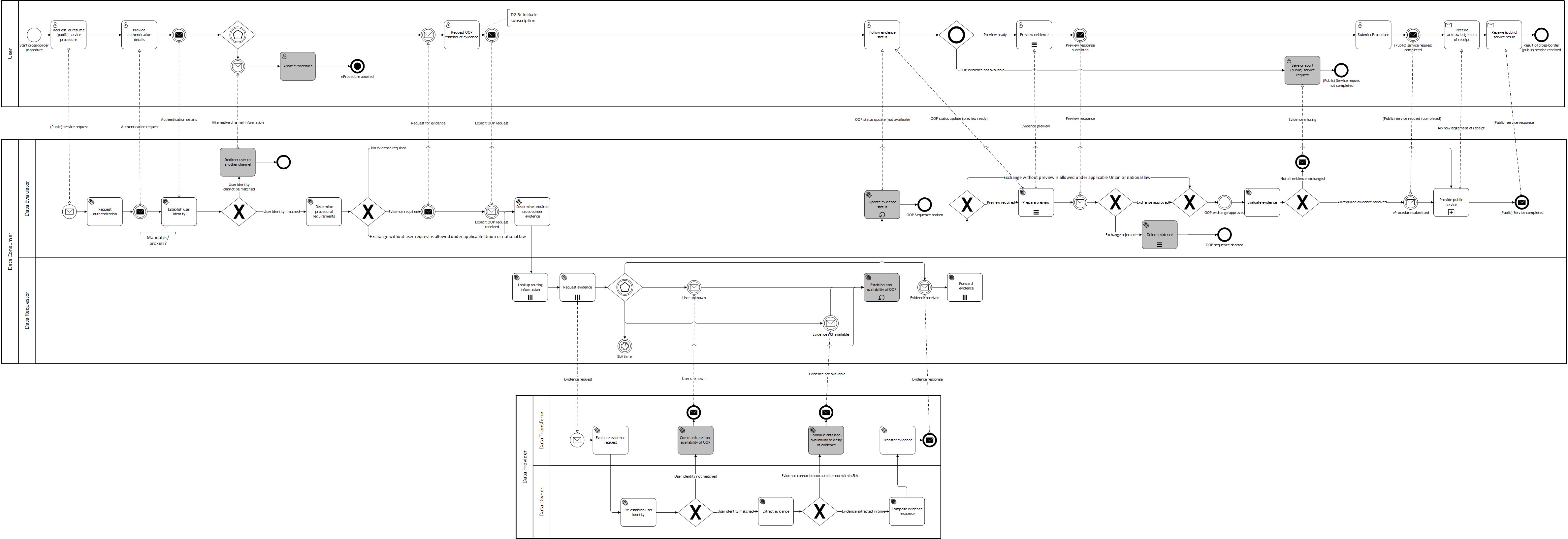You signed in with another tab or window. Reload to refresh your session.You signed out in another tab or window. Reload to refresh your session.You switched accounts on another tab or window. Reload to refresh your session.Dismiss alert
User Supported Intermediation Pattern (USIP) provision
provisionType (e.g. usip)
redirectURL (e.g. https://ctie.lu/usip)
Intermediation Pattern (IP) provision
provisionType (e.g. ip)
[ params ]
title (e.g. SI/nuts3)
[ paramset ] (optional)
type (e.g. SI031)
If country is not in the system an empty or null response is retrieved.
The user selects the ial provision per canonical type.
If only 1 provisions per canonical type is provided it is selected automatically.
If more provisions per canonical type are provided, user selects 1 (i.e. Provision).
The user selects to upload the evidence per canonical type (optional).
If country is not in the system (the request to /ial/{canonicalEvidenceTypeId}/{countryCode} is not successful).
If use does not confirm 1 of the provided provisions.
The user confirms the selection to proceed.
The MOR returns the selected ial provision by writing the corresponding JSON structure in the javascript array of the parent window whose id was specified as input parameter.
Output
Explicit OOP request response message from the user to Data Evaluator.
Output parameters of the MOR component:
[ outputJSArrayId = ialProvisionData ]
Postconditions
User continues to follow the evidence status.
Data Evaluator's workflow is redirected to Data Requester, Data Transferor and Data Owner that provides the evidence.
The text was updated successfully, but these errors were encountered:
DejanL
changed the title
Implementation of explicit request page
Implementation of explicit request (ER) page
Nov 15, 2021
MOR Explicit Request (ER)
Supported activities
Request OOP transfer of evidenceactivity in both patterns.Intermediation Pattern (IP)

User-supported Intermediation Pattern (USIP)

Hosting environment
Actor
Preconditions
Input
defaultLangen,sl,esetc. → ISO 639-1:2002requesterCountryCodeSI,ESetc. → NUTS 0[ canonicalEvidenceType ]enum CanonicalEvidenceType(HigherEdCertificate,SecondaryEdCertificate,ResidencyProof,BirthCertificate,MarriageCertificate,CompanyRegistration) →ial.yaml,morJSONvariable →mor.js)outputJSArrayIdInteractions
mor_{languageCode}.json→mor_en.json,mor_sl.json,mor_es.jsonetc.)./ial/{canonicalEvidenceTypeId}/{countryCode}→ial.yaml.atuLevel→ Administrative Teritorial Unit (see example inatusJSONfrommor.js)ProvisionItem(see example inial.yaml)atuCode(e.g.ES)atuLatinName(e.g.España)dataOwnerId(e.g.urn:de4a-eu:provision::9920:ESS2833002E:BirthCertificate)dataOwnerPrefLabel(e.g.Ministerio de Justicia) → this is displayed in MOR componentProvision(see example inial.yaml)provisionType(e.g.usip)redirectURL(e.g.https://ctie.lu/usip)provisionType(e.g.ip)params]title(e.g.SI/nuts3)paramset] (optional)type(e.g.SI031)Provision)./ial/{canonicalEvidenceTypeId}/{countryCode}is not successful).Output
[ outputJSArrayId = ialProvisionData ]Postconditions
The text was updated successfully, but these errors were encountered: